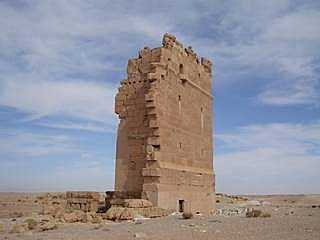Qasr al-Hayr al-Gharbi

Qasr al-Hayr al-Gharbi castle (Arabic: قصر الحير الغربي), located 80 km south-west of Palmyra on the Damascus road, is a twin palace with Qasr al-Hayr al-Sharqi, built by the Umayyad caliph Hisham ibn Abd al-Malik in 727 CE. The architectural view was a Byzantine one.
It was used as an eye of the king during the Umayyad era, to control the movement of the desert tribes and to be a barrier against them, as well as being a hunting chalet. Later it was utilized by the Ayyubids and the Mamelukes but was abandoned permanently after the Mongol invasions.
The castle is quadrangular in outline with 70-meter sides. The central doorway to the castle is very attractive, and has been moved to the National Museum of Damascus to be used as the entrance. Its semi-cylindrical towers on the sides of the doorway, columns, and the geometric shapes mirrored a blend of Persian, Byzantine and Arab architecture.
Not much remained from the castle. Only visible is a reservoir to collect waters from Harbaka dam, a bath and a khan.
The gateway is presently preserved as a façade in the National Museum of Damascus.
Sources
| Wikimedia Commons has media related to Qasr al-Heir al-Gharbi. |
See also
Coordinates: 34°22′28″N 37°36′21″E / 34.37444°N 37.60583°E